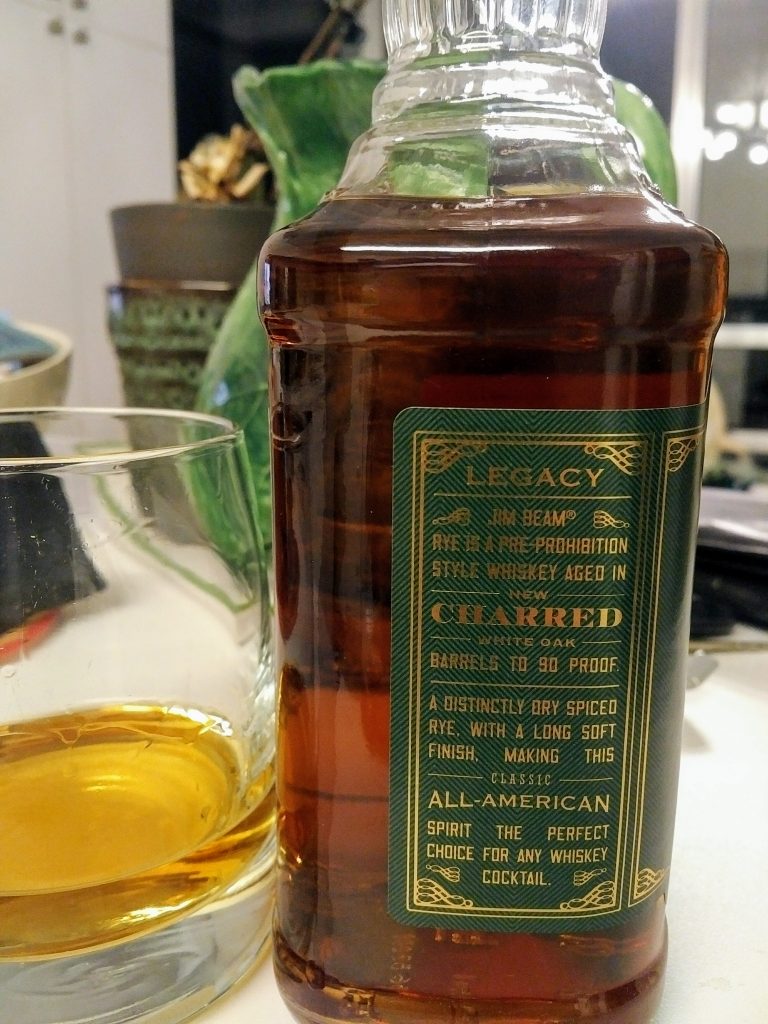[Friendly caution to our beer and historical-anything readers: contemporary technical rye whiskey discussion ahead].
Pictured is the rebadged rye of Beam Suntory, now 90 proof vs. the former 80 proof Yellow Label (Jim Beam Straight Rye). It’s called Pre-Prohibition Style vs. simply straight rye for the old Yellow Label (now discontinued). The new one is straight too though, the label states this as well, in effect at least four years old.
Beam still produces (RI)1 Straight Rye, at 92 proof seemingly a ratchet-up, and maybe different batching, of 80 proof Old Overholt rye, in turn also seemingly the same recipe as Knob Creek Straight Rye. AFAIK, all these are the same mashbill but different proofs, selections, and/or ages.
Truth to tell, having tasted them for years except the relatively new Prohibition one, they were very similar in palate. They all had a pungent, not all-that-appealing flavour which to me was the Beam signature, also seen in its various bourbons.
When I was active with www.straightbourbon.com, some of us called it the yeast taste, a potent background flavour common to the bourbon and rye. Hence thinking it was one Beam yeast used for fermenting rye and bourbon mashes that imparted the taste, although perhaps there was another explanation.
It’s still in Beam’s bourbons, e.g. I noticed it in a recent Knob Creek, but is almost completely absent in the Pre-Prohibition rye.
If one mixes any of these, the effect won’t be noticed, but drunk neat, the Beam “smack” was always very distinctive.
This taste must have evolved at the Clermont and Boston distilleries of Beam in the last 20 years or so, as I’ve tasted 1970s Beam bourbons at Kentucky gatherings and they don’t have it. Those bourbons were richer and more caramel-like than today’s, “carmul” as my good American friends would say (we say, car-a-mel, long “a” vs. their short “a”).
Old Gran-dad bourbon had a similar taste although as made at National Distillers in the 1970s was different again, more fruity and rich. Yet apparently the yeast for Gran-dad used at Beam came from National Distillers and is different than Beam’s yeast for its own brands, so who knows.
I wonder if the type of rye traditionally used at Beam may impart the taste in question since the bourbons use some rye too of course.
Since I like these whiskeys neat, small differences mean lot, and I was very happy to note that Pre-Prohibition rye doesn’t have the taste. It is rich, very drinkable neat, silky-sweet, and if it has any of the yeast smack it’s just a hair. Personally I think a different yeast is used to mash this formula.
It’s excellent value given where bourbon and American rye prices are these days.
A few large distilleries today mash rye, Beam does, Heaven Hill (Pikesville, Rittenhouse), of course MGPI in Indiana. Jack Daniel does a rye now too, rather bland IMO – I don’t know why since the white dog had a strong new-whiskey taste, but aged it seems a different animal.
There is also Brown-Forman’s Woodford Reserve Rye, all pot-distilled, I believe, in the small Versailles, KY plant. It reminds me of Woodford Reserve bourbon for years after its original release, fairly congeneric albeit my last WR bourbon seemed older in taste, quite an improvement. But I’d guess the rye hasn’t had time to age more than four years.
The pot-distilling, while salutary historically, requires years of aging to bring around.
There is also Sazerac’s Barton 1792 Distillery’s Fleischmann Rye, still made in Bardstown for a limited market and hard to find. Excellent product for the price.
Finally, Wild Turkey has a rye, in 101 and regular proof iterations. I’ve never been a fan of the profile, certainly good for cocktails though.
Diageo’s George Dickel rye is from MGPI except for the maple charcoal leaching. I’m not really a fan of the MGPI profile for rye, I find it rather harsh (“Blue Tide”) but maybe I haven’t tried it old enough.
There are countless craft distillers doing rye of course, but the products I’ve tried are quite young and don’t get at the aged side of the taste spectrum, which is the traditional one at least for 100 years or so. I.e., aging starts at four years old and often climbs much higher.
I had a Sazerac 18-year-old rye dram courtesy my friend Gary Hodder recently that was outstanding. The taste you get in old rye is quite different to old bourbon, kind of gingerbread-like or – again a term I used to use on the straightbourbon.com board – old damask curtains.
The Sazerac 18-year-old rye was either made years ago in Buffalo Trace Distillery, Frankfort, KY, formerly Ancient Age Distillery, or possibly in Louisville at “Old Bernheim”, now Heaven Hill’s distillery in Louisville, rebuilt 1992 as New Bernheim by UDV/Guinness (predecessor of Diageo) and tanked.
Beam Suntory has a Canadian rye too, Canadian Club Chairman’s Select 100% Rye made at Alberta Distillers. It’s very good when well-batched and selected*, all aged in new charred oak, but quite different to the Kentucky ryes in the stable.
……………………………………………………………………………………………………………………….
*Just as an example, currently if you buy some CC brands in Ontario you get a free mini, so I got a mini of the CC 100% rye that way. It was light-coloured and lean in taste, not as good as the full bottles currently on the shelf which are rich and malty. Hence maybe the freebie? Of course we don’t look a gift horse in the mouth. It made a good addition to a brandy-based Sazerac cocktail. 🙂



Dont forget the Alberta Rye Dark Batch which is basically that 100% rye blended with Old Grand Dad and some Sherry. Might be odd but I drink it neat quite often and love it.
Yes Alan, thanks, good product, but there is some blended whisky as well in there, 12 years old.